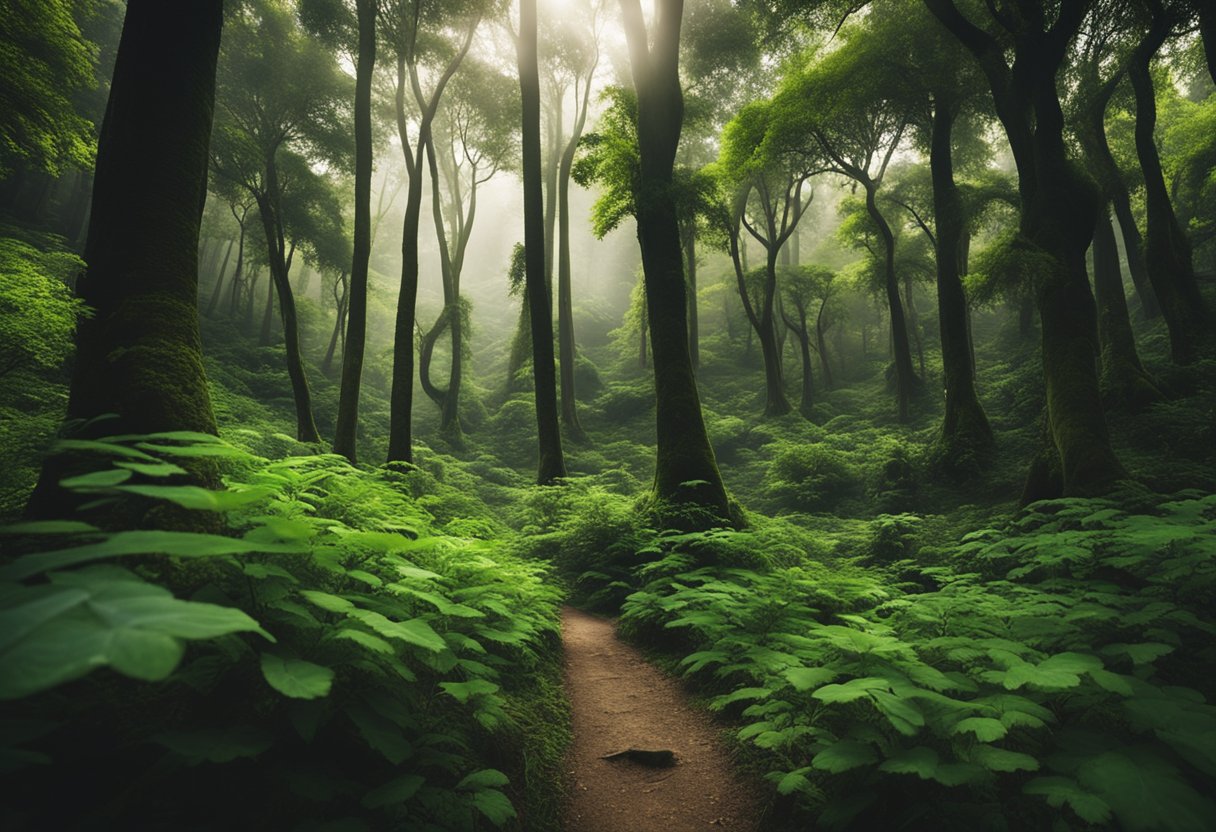Sacred Groves Worldwide: Unveiling Global Nature Sanctuaries

Updated On: April 15, 2024 by Raghda Elsabbagh
Sacred groves are nature’s sanctuaries, revered areas of vegetation preserved by various cultures around the globe, representing a rich tapestry of biodiversity and spiritual significance. These pockets of untouched land are often ingrained in local traditions, encapsulating the harmonious relationship between nature and spirituality. Historically, they serve as a testament to humanity’s reverence for the natural world, often centred around beliefs and practices aimed at protecting these areas from harm. In diverse cultures, each sacred grove carries its unique story, integrating the ecological with the cultural, manifesting in practices that have shielded them from the overreach of development and exploitation.

In the contemporary context, the conservation of sacred groves offers vital insights into long-standing nature conservation strategies, contributing substantially to the preservation of biodiversity. They stand as crucial refuges for numerous species, many of which are endemic or threatened. The care and management of these groves often fall to local communities, whose participatory roles underscore the importance of combining traditional knowledge with modern conservation efforts. Recognising these groves within the wider landscape of environmental protection highlights their potential as reservoirs of ecological stability and cultural heritage.
Historical Significance of Sacred Groves
In our exploration of the world’s natural sanctuaries, we find sacred groves hold a profound historical significance. These treasured sites are living vestiges of the intertwining between ecological stewardship and spiritual practices.
Religious and Mythological Roots
Sacred groves date back to ancient times, often rooted in the religious and mythological beliefs of local and indigenous communities. These natural temples served as earthly abodes for deities or ancestral spirits. For example, in parts of India, each grove is dedicated to a local deity and is a testament to traditional knowledge being passed through generations. The spiritual values attached to these groves reinforce a sense of reverence, which has been instrumental in their preservation.
Conservation Through Traditions
Engaging with sacred groves showcases a unique form of environmental conservation that is intrinsically linked with traditions. These sites are often protected by local communities and indigenous people because of their spiritual value, leading to the conservation of biodiversity and natural resources. The underlying philosophy of sacred groves is not just a conservation method but a way of life which embodies the respect for nature seen in many traditional and indigenous cultures across the globe.
By valuing these groves, we pay homage to the traditional knowledge and spiritual values that have safeguarded these pockets of wilderness through the ages. Sacred groves are not only important for their biodiversity but also for the cultural heritage they represent.
Sacred Groves and Biodiversity
In the pursuit of understanding nature’s sanctuaries, we turn our attention to sacred groves, which play a pivotal role in preserving biodiversity and supporting ecosystems. We examine the contributions of these valuable biotic areas to flora and fauna diversity and the assorted ecosystem services they provide.
Flora and Fauna Diversity
Sacred groves are treasure troves of biological diversity, often housing endemic species that are not found elsewhere. The untainted nature of these groves offers a refuge for a wide range of species, providing habitats that are essential for their survival. For example, in the spiritual connection with nature, we see how communities traditionally protect sacred groves, attributing to their rich biodiversity and the enduring presence of both common and rare species.
Ecosystem Services and Benefits
The ecological services rendered by sacred groves are manifold. They not only harbour diverse ecosystems but also contribute to the stability of local climates, water purification, and soil fertility. The sacred groves act as natural sanctuaries that hold immense ecological service benefits, such as sustaining the genetic diversity of flora and fauna and providing resources and materials for indigenous medicines.
Observations from the Global South have underlined sacred groves as a panacea for sustainability, related to cultural values and indigenous belief systems which play a significant part in the protection efforts of these areas. By nurturing these sanctuaries, we are essentially safeguarding the intricate web of life that thrives within them.
Threats to Sacred Groves

Sacred groves are vital for biodiversity conservation and carbon sequestration, but they face significant threats which undermine their ecological and cultural value.
Deforestation and Climate Change
The expansion of agricultural land and other forms of deforestation have resulted in the loss of many sacred groves. These practices not only reduce biodiversity but also impact climate change as they diminish the ability of these groves to sequester carbon. Moreover, climate change itself exacerbates the problem by altering the conditions that many species need to survive, further threatening the integrity of these verdant havens.
Urbanisation and Agriculture
The spread of urbanization brings with it the construction of infrastructure, leading to habitat fragmentation. Sacred groves, revered for their cultural importance, are not immune to the encroachment of urban expansion. Additionally, the conversion of land for agriculture, including crop cultivation and livestock grazing, has led to the degradation of these natural sanctuaries. These activities not only impinge on the vital role groves play in habitat protection but also imperil the myriad of life forms that depend on them.
Sacred Groves in the Himalayas

In the serene heights of the Himalayas, sacred groves are not just forests but are emblematic of the profound eco-spiritual practices that have been conserved over generations.
Eco-Spiritual Practices
The concept of sacred groves in the Himalayas, particularly in Uttarakhand, revered as ‘Dev Bhoomi’ or the ‘Land of the Gods’, intertwines religious piety with environmental stewardship. The local communities hold these groves in high esteem, often associating them with local deities and using them as places of worship. These practices play a crucial role in the protection of these areas, as the divine association forbids any form of exploitation, thereby keeping the groves in their pristine state.
Himalayan Biodiversity and Conservation
The Himalayan region boasts a rich biodiversity featuring a multitude of species, some of which are endemic to these heights. Sacred groves often fall within or adjacent to protected areas, forming critical habitats and conservation sites. They serve as refuges for wildlife and play a key role in preserving genetic diversity. These groves act as natural reserves, aiding in maintaining ecological balance and ensuring that the various life forms, including rare and endangered species, continue to thrive in the region.
Protection and Management of Sacred Groves
In managing sacred groves, we integrate traditional practices with contemporary conservation efforts, ensuring these vital biodiversity hotspots endure for future generations.
Indigenous Stewardship and Cultural Norms
Maintaining the Sanctity: We honour the traditional custodians of sacred groves who have shielded these grounds through cultural norms and religious taboos. These restrictions, often unwritten, form a crucial barrier against the exploitation of these areas, preventing activities such as logging and poaching. Their effectiveness lies in the deep spiritual connection that the local communities maintain with their sacred sites, which fosters a sense of collective responsibility.
International Recognition and Support
Strategic Alliances for Conservation: We leverage the support of international bodies like the International Union for Conservation of Nature (IUCN) and the United Nations Educational, Scientific and Cultural Organization (UNESCO) to fortify the protection of sacred groves. These alliances help in the solicitation of international recognition and support, which translates into funding, policy advocacy, and research. They thrust these local conservation efforts onto a global platform, ensuring sacred groves are not only recognised as repositories of ecological wealth but also as cultural landscapes needing preservation.
By anchoring traditional knowledge in global environmental frameworks, we craft a symbiotic relationship where both cultural integrity and biodiversity can flourish.
Community Participation and Local Traditions
Engaging local communities is essential to the protection and preservation of sacred groves. Through community-based conservation models and the engagement of local people, we can appreciate the depth of cultural values intertwined with natural sanctuaries.
Community-Based Conservation Models
We recognise that conservation is most effective when local people are actively involved. In areas where sacred groves protect biodiversity, communities often use traditional knowledge to manage these sites. Such community-based conservation approaches not only bolster environmental efforts but also reinforce cultural practices. These models hinge on collaborative decision-making, ensuring that local voices are heard and that their intimate understanding of the ecosystem guides conservation activities.
Engagement of Local People
Participation goes beyond consultation; it encompasses the active role of local people in managing sacred groves. We see that by honouring local traditions and cultural values, conservation becomes a communal objective. For instance, in Ghana, traditional sacred grove institutions are key to biodiversity protection. Such engagement ensures that conservation measures are not only enforced but also woven into the fabric of everyday life, making them much more sustainable. Sacred groves thrive when local communities are the caretakers and, in turn, serve as a means to preserve their way of life.
Case Studies of Sacred Groves
In examining sacred groves around the world, we focus on two distinct regions: the Western Ghats in Karnataka, celebrated for their rich biodiversity, and the serene sacred forests of Meghalaya.
Western Ghats’ Rich Ecosystems
The Western Ghats, a UNESCO World Heritage site, harbour an exceptional array of plant and animal species. Karnataka’s section of these mountains is notable for its sacred groves, known locally as devarakadus. These are not merely sanctuaries preserving biodiversity; they embody the socio-cultural fabric of the local communities, integrating spirituality with conservation. For example, in the Kodagu district of Karnataka, sacred groves act as genetic reservoirs and are pivotal in maintaining ecological balance.
The Sacred Forests of Meghalaya
Moving to the northeast of India, Meghalaya’s sacred groves are prime examples of community-conserved areas. The Khasi and Jaintia tribes of Meghalaya have maintained these forest patches for centuries, bestowing them with religious significance. In the Khasi Hills, a location such as the Mawphlang Sacred Forest is revered and thus fiercely protected, an embodiment of the profound connection between indigenous beliefs and conservation practices. These groves are also essential in preserving soil fertility and providing clean water sources.
Sacred Groves in Different Cultures
Sacred groves serve as vital elements for cultural and biodiversity conservation, showcasing the deep reverence various societies hold for nature.
Variations Across Mainstream Faiths
Hinduism: Within the practices of Hinduism, sacred groves are known as devraija or devarkadu, where they are seen as abodes of deities and a space for spiritual practices. Throughout India, these centuries-old traditions remain vibrant, with local communities actively participating in their protection.
Church forests: In Ethiopia, the notion of a sacred grove takes the shape of church forests, which are green sanctuaries surrounding Ethiopian Orthodox Tewahedo churches. This unique tradition exemplifies how mainstream faiths integrate natural conservation with religious observance, safeguarding these patches of biodiversity as a form of divine stewardship.
Global Distribution and Cultural Practices
Japan: Japan’s culture holds its own version of sacred groves in the form of Shinji Shumeikai, green spaces considered spiritually significant and often connected to Shinto shrines. This exemplifies the universal significance of nature sanctuaries in spiritual practices across cultures.
Cultural diversity: The concept transcends geographic and cultural boundaries, embracing a diverse array of practices worldwide. Beyond the religious scope, cultural preservation plays a pivotal role as each community’s customs and folklore are intertwined with these living sanctuaries.
The existence of sacred groves across the globe highlights a shared human inclination to revere and protect the natural environment—a testament to our cultural diversity and the myriad ways in which we find connection through nature.
Modern Perspectives on Sacred Groves
In the contemporary context, sacred groves are seen through a lens that harmonises ecological science with traditional beliefs, acknowledging their role in conserving biodiversity and providing ecosystem services.
Interplay of Science and Religion
Science and traditional belief systems converge in our recognition of sacred groves. Various cultures have long revered these sites and are now acknowledged for their ecological significance. Our reverence for these groves aligns with their ability to preserve genetic diversity and act as refugial spaces for rare species. The scientific investigation confirms the effectiveness of these sacrosanct areas in maintaining ecological balance and underscores their role in biodiversity management.
Sacred Groves as Biodiversity Hotspots
Sacred groves act as biodiversity hotspots and are crucial in biodiversity management. We witness a varied array of endemic species thriving within these protected zones, which is testament to the conservation value these groves hold. Our analysis reveals that these groves, often untouched by modern agricultural and industrial practices, sustain a wealth of biodiversity and ecosystem services. By maintaining these habitats, we safeguard the evolutionary history they contain and ensure the provision of crucial ecosystem functions.
Conservation Strategies and Policy Planning
When safeguarding sacred groves, strategic policy planning and conservation efforts are central. We focus on implementing robust legislation, establishing protected areas, and fostering community initiatives backed by governmental support.
Legislation and Protected Area Designation
Sacred groves benefit from legal protection through legislation that recognises their significance. These laws serve to establish protected areas wherein activities harmful to ecosystems are restricted. By codifying such regions as protected, governments acknowledge the vital role these groves play in biodiversity conservation and cultural heritage preservation. For instance, the International Union for the Conservation of Nature (IUCN) works to classify these groves, giving them a status that helps in ensuring their protection.
Community Initiatives and Governmental Support
Beyond legislation, the engagement of local communities, including indigenous peoples and forest dwellers, is crucial. These groups often hold traditional knowledge and practices that have preserved sacred groves for generations. Government support can empower these communities through initiatives that provide the means for sustainable management and conservation. By blending traditional wisdom with contemporary conservation techniques, a holistic approach emerges, effectively maintaining these natural sanctuaries.
Governmental support can further be seen in the endorsement of conservation projects and funding, which, together with community-led actions, creates a synergistic effect in preserving these areas’ ecological and cultural values.
Frequently Asked Questions

In this section, we’ll address some key queries about sacred groves, exploring their historical significance, the species they shelter, how they bolster biodiversity, cultural associations, ecological advantages, and ongoing protection efforts.
What is the historical significance of sacred groves?
Sacred groves have historically been revered as areas of spiritual and ecological importance. Many ancient cultures believed these forests to be dwellings of deities, leading to their careful preservation over centuries. For instance, sacred groves in India serve as a testimony to the relationship between spirituality and environmental conservation.
Which fauna species are typically found in nature’s sanctuaries?
Nature’s sanctuaries, such as sacred groves, are home to a range of fauna, often providing a refuge for endangered species. These groves offer crucial habitats for myriad creatures, from insects and birds to larger mammals. The protected status of sacred groves remains vital in preventing habitat loss for these species.
How do sacred groves contribute to biodiversity conservation?
Our sacred groves act as biodiversity hotspots, often harbouring a greater variety of species than surrounding landscapes. These groves are critical for conservation as they offer undisturbed ecosystems, enabling both flora and fauna to thrive and maintaining genetic diversity.
What cultural practices are associated with sacred groves in various countries?
Cultural practices linked to sacred groves vary greatly across countries. In Ghana, for example, the Ga people’s Kpele taboo forbids harming sacred grove flora and fauna. Meanwhile, in Japan, Shinto shrines are often surrounded by these groves, reflecting a deep-rooted tradition of nature worship.
Can you identify the ecological benefits of preserving sacred forests?
Preserving sacred forests yields multiple ecological benefits. They serve as natural water catchments, aid in soil conservation, and help in climate regulation. These groves also offer a natural defence against erosion and support pollination networks essential for many plant species.
What are some of the endangered sacred groves and what are the efforts to protect them?
Several sacred groves are currently under threat due to deforestation and urbanisation. However, efforts are being made to protect them, ranging from community-led conservation initiatives to legal protection measures. Groves like the Kaya forests in Kenya receive attention for their cultural and ecological significance, with ongoing recovery and safeguarding projects.






